1. Basic Principles of Jewellery Design
Jewellery design is more than just crafting adornments; it’s about creating pieces that resonate with emotions, stories, and aesthetics. At its core, balance ensures that every element, be it a gemstone or a metal piece, complements the others, creating a harmonious look. Contrast, often achieved by juxtaposing different materials or colors, adds depth and intrigue.
Proportion ensures that each segment of the design feels right in relation to the others, neither too large nor too diminutive. Movement brings dynamism, guiding the viewer’s eyes across the piece, while unity binds all elements into a coherent, compelling narrative. Having immersed myself in this art, I’ve come to appreciate how these principles are the silent notes behind every melody of design.

2. Materials in Jewellery Manufacture
When discussing jewellery design and manufacture, materials are at the heart of the process. These components not only determine the aesthetics and durability of the piece but also influence its market value and appeal. Delving deeper into the world of jewellery manufacture, several materials stand out due to their widespread use and significance.
Stones
The allure of gemstones in jewelry is timeless, capturing the essence of nature’s beauty and the artistry of human craftsmanship. Stones have been used as symbols of power, love, and affluence throughout history. Their variety in color, hardness, and rarity makes them cherished additions to jewelry pieces, often determining the value and significance of the ornament. Here are its common types:
- Diamond: Diamond is the hardest known natural material on Earth, rating a 10 on the Mohs scale of mineral hardness. It is formed under high temperature and pressure conditions deep within the Earth’s mantle, largely composed of carbon. For example, those engagement rings commonly feature diamonds due to their brilliance and symbol of enduring love.
- Ruby: Ruby is a red gemstone that is considered one of the four precious stones, alongside sapphire, emerald, and diamond. It gets its red color primarily from the mineral corundum, which contains chromium. Rubies are used in various pieces of jewelry, from rings to pendants, for their vibrant color and luster.
- Sapphire: Sapphire is typically blue but can come in a range of other colors, excluding red (those are rubies). It is the second hardest gemstone after diamond, making it durable for everyday wear. Often seen in jewelry items like earrings, sapphires are also chosen for engagement rings.
- Emerald: Emeralds are green gemstones that belong to the beryl mineral family. Their green color can range from light to deep green, depending largely on the amount of chromium and vanadium. Due to their color and rarity, they’re highly valued and often set in necklaces and rings.

Metals
Metals form the foundational structure of most jewelry, chosen not just for their aesthetic appeal but also for their strength, malleability, and durability. Since ancient times, various metals have been forged, molded, and adorned to create lasting symbols of status, commitment, and identity.
The choice of metal can influence a jewelry piece’s longevity, appearance, and how it interacts with the wearer’s skin. Let’s explore these metals:
- Gold: Gold is a highly malleable metal, known for its yellow hue and resistance to tarnish and rust. It is commonly used in jewelry and can be alloyed with other metals to create different colored golds, such as white, rose, or green.
- Silver: Silver is a white, shiny metal that is more abundant than gold but tarnishes when exposed to sulfur compounds in the air. It is often used in jewelry, especially in necklaces, earrings, and bracelets. Sterling silver, an alloy containing 92.5% silver, is a popular choice for jewelry due to its strength and durability.
- Platinum: Platinum is a dense, malleable metal with a silvery-white appearance. It’s more rare than gold and is hypoallergenic, making it a top choice for those with sensitive skin. Jewelry made of platinum is often more expensive because of its rarity and durability.
- Titanium: Titanium is a strong, lightweight metal known for its corrosion resistance and high strength-to-weight ratio. It has a darker, gunmetal gray color, setting it apart from silver and platinum. Due to its biocompatibility, it’s often used in body jewelry and for pieces worn by those with metal allergies.

3. The Design Process
The journey from conceptualization to a finished jewelry piece is both an art and a meticulous task. Behind every necklace, ring, or bracelet lies a systematic design process that ensures the piece’s aesthetics, functionality, and manufacturability. This process involves various steps, below are the ff:
Step#1 Conceptualization
It’s where the designer draws inspiration, be it from nature, architecture, history, or personal experiences. This phase allows for the birth of ideas and sets the direction for the upcoming design. Sketchbooks or digital tools might be used to jot down initial thoughts and concepts. A visit to a botanical garden might inspire the creation of a leaf-themed necklace, with intricate details reminiscent of natural foliage.
Step#2 Detailed Sketching
Once the initial idea is formulated, the next step is creating detailed sketches. These sketches represent the design’s exact dimensions, detailing, and even the proposed materials. It is crucial to get these drawings as accurate as possible because they serve as the foundation for the next steps.
During this stage, the feasibility of the design is also considered, ensuring that it’s not only beautiful but also manufacturable. Having sketched hundreds of designs over the years, precision at this stage is paramount.
Step#3 3D Modelling and Prototyping
With advancements in technology, 3D modeling has become a pivotal step in jewelry design. Using software, the detailed sketch is transformed into a three-dimensional digital model. Providing a realistic view of how the finished piece will look and allows for any adjustments before actual production. Once satisfied with the digital model, a prototype can be created using 3D printing or traditional methods to physically review the design.
Step#4 Material Selection
After the design has been solidified, the next phase involves choosing the right materials. The choice of metals and gemstones will dictate the piece’s final look, feel, and value. Factors like durability, color, malleability, and cost play a role in this selection.
Whether it’s opting for rose gold for its romantic hue or selecting a sapphire for its deep blue allure, each material adds a unique touch to the design. As an example, a design might be envisioned in silver, but upon evaluation, stainless steel might provide a more contemporary look and feel.
Step#5 Final Crafting and Finish
The culmination of the design process is the actual crafting of the jewelry piece. Craftsmen and artisans take the prototype and using the chosen materials, bring the design to life. The jewelry undergoes various stages, from casting to setting gemstones, followed by polishing and other finishing touches.
Once completed, the piece is thoroughly inspected for any imperfections or deviations from the original design. The transformation from a mere idea to a tangible piece of art is truly a rewarding experience.
4. Manufacturing Techniques
Jewellery design is only half the story; bringing that design to tangible life requires expertise in various manufacturing techniques. Over time, artisans have honed and perfected numerous methods, ensuring the creation of exquisite pieces that delight and endure.
In the intricate journey of jewellery design and manufacture, specific techniques stand out due to their unique applications and results. Let’s explore these techniques:
Casting
Casting is a foundational technique where molten metal is poured into molds to create jewelry pieces. The mold can be made from materials like wax, clay, or metal, depending on the desired outcome. Once the metal cools and solidifies, the mold is broken or melted away, revealing the formed jewelry piece.
This method allows for creating multiple replicas of the same design efficiently. At Rexjewel, this precision-driven process is central to producing consistent and quality pieces for every clientele.
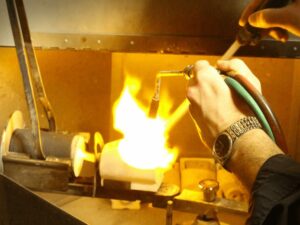
Hand Fabrication
Hand fabrication is a testament to the artisan’s skills and dexterity. This technique involves manually shaping and joining metal pieces using tools like hammers, mandrels, and torches. Each piece crafted via hand fabrication is unique, bearing the subtle nuances of the craftsman’s touch.
This method is often preferred for one-of-a-kind pieces or custom designs. As I personally crafted a ring through hand fabrication, the connection between the artisan and the creation becomes deeply intimate.
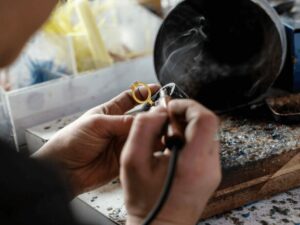
Lost Wax Process
A subset of casting, the lost wax process involves creating a model of the jewelry piece in wax. This wax model is then encased in a ceramic material, which is heated until the wax melts and is “lost.” Molten metal is then poured into the resultant cavity. Once cooled and set, the ceramic mold is broken away, leaving behind a metal replica of the original wax model.
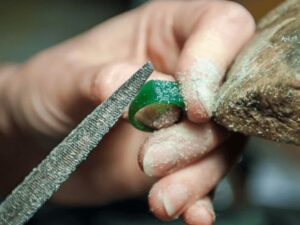
Electroforming
Electroforming is a technique where metal is deposited onto a form or mold using an electrical process. A conductive surface (often the desired jewelry piece) is submerged in a solution containing metal particles. When an electric current is applied, metal ions from the solution are deposited onto the conductive surface, gradually forming a layer.
According to Surface Treatment Experts, electroforming metals atom by atom enables unparalleled precision with details and components, achieving tolerances up to one micrometer. An elegant, hollow necklace that appears heavy but is surprisingly light might have been crafted using electroforming.
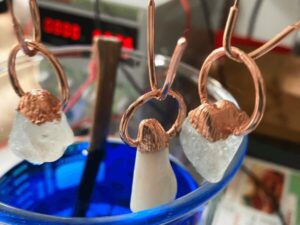
Stone Setting
Stone setting is the art of securely embedding gemstones into jewelry. Different types of settings, such as prong, bezel, or channel, are chosen based on the gemstone’s size, shape, and the overall design of the jewelry piece. The setting not only secures the gemstone but also enhances its appearance, ensuring it captures light optimally.
Proper stone setting is crucial, as it dictates the gemstone’s prominence and the jewelry’s overall aesthetic. A radiant diamond ring, its stone glistening from every angle, exemplifies the importance and skill behind this technique.

5. Sustainability in Jewellery Design and Manufacture
The jewelry industry, like many sectors, is increasingly being called upon to adopt sustainable practices. As concerns about environmental impact and ethical sourcing grow, jewelers are innovating to ensure that their products are not only beautiful but also kind to the planet and its inhabitants. Here are three notable sustainability practices in jewelry design and manufacture:
Ethical Gemstone and Metal Sourcing
One of the most important sustainability practices in jewelry design is the ethical sourcing of gemstones and metals. Mining, especially for precious stones and metals, can have significant environmental impacts and can sometimes be associated with human rights abuses.
Ethically sourced gems and metals ensure that they are obtained in a manner that respects both the environment and the people involved in mining and production. Certifications, such as those from the Responsible Jewellery Council, can help consumers identify ethically sourced products.
Recycled Materials
By repurposing old or discarded jewelry or using metals that have been previously mined and processed, designers can reduce the demand for new mining activities. This also minimizes the energy consumption and environmental footprint associated with extracting and processing new raw materials. Recycled jewelry can be just as beautiful and durable as those made from newly mined resources.
Sustainable Packaging
The experience of buying jewelry often comes with exquisite packaging, which unfortunately can also be wasteful. Adopting sustainable packaging practices means using materials that are recyclable, biodegradable, or made from post-consumer waste.
By doing so, jewelers can reduce their carbon footprint, minimize waste going to landfills, and offer their customers an eco-friendlier unboxing experience. Such practices underscore the brand’s commitment to sustainability and can enhance its appeal to eco-conscious consumers.
6. Quality Assurance and Hallmarking
In the world of jewelry design and manufacture, ensuring the authenticity and quality of materials and craftsmanship is paramount. This not only upholds the integrity and reputation of brands but also instills confidence in consumers making significant investments. To achieve this, various quality assurance tests and hallmarking practices are employed. Here are three notable ones:
- Assaying: A process used to determine the composition and purity of metals, especially precious metals like gold, silver, and platinum. By analyzing the metal content, assayers can confirm whether the jewelry meets the declared purity standards. Once the metal’s purity is verified, it’s typically hallmarked to certify its content.
- Gemstone Grading: Specialized labs and gemologists use a combination of visual inspections under magnification and advanced instrumentation to assess the quality and authenticity of the gemstone. This ensures that stones are not synthetically produced, and it helps determine their market value.
- X-Ray Fluorescence (XRF) Testing: XRF is a non-destructive testing method used to determine the composition of jewelry. By exposing the jewelry to X-rays, the resulting fluorescence emitted by the metal is measured. This can determine the concentrations of various elements present, ensuring that the jewelry’s metal content is as declared.
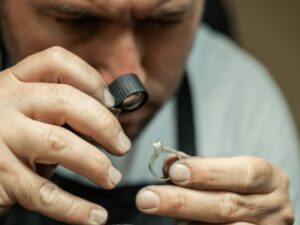
7. Future Trends in Jewellery Design and Manufacture
As the world evolves, so does the realm of jewellery. Advancements in technology, shifts in consumer preferences, and a growing focus on sustainability are collectively reshaping the landscape of jewellery design and manufacture. This dynamic field is set to witness several exciting trends that will redefine both its aesthetics and its production methods. Let’s cast a gaze into what the future holds:
Sustainable and Ethical Materials
The growing consciousness towards the environment and ethical practices has spurred a demand for sustainable jewellery. Designers and manufacturers are increasingly turning to recycled metals, lab-grown diamonds, and ethically sourced gemstones. Such materials not only lessen the environmental impact but also address ethical concerns related to mining.
Integration of Technology with Craftsmanship
The union of traditional craftsmanship with cutting-edge technology is paving the way for innovative creations. Techniques like 3D printing, virtual reality (VR) for design visualization, and artificial intelligence (AI) in design prediction are revolutionizing the way jewellery is conceived and created.
This integration enables designers to push boundaries, experiment with intricate patterns, and reduce wastage in the manufacturing process. From my vantage point, it’s exhilarating to witness the harmonious melding of age-old skills with modern innovation.
| Aspect |
Craftsmanship |
Technology |
| Authenticity |
Unique, hand-made pieces |
Digital designs can be replicated easily |
| Customization |
Ability to cater to specific individual requests |
CAD designs can be easily modified for customization |
| Precision |
Skill-dependent accuracy |
High precision with tools like laser cutting |
| Speed of Production |
Typically slower due to manual processes |
Faster production especially for bulk orders |
| Design Complexity |
Limited to the artisan’s skills and tools |
Can create intricate and complex designs with software |
| Reproducibility |
Difficult to create exact duplicates |
Easy replication of designs |
| Cost |
Labor-intensive, often resulting in higher prices |
Economies of scale possible, potentially lower prices for bulk |
| Skill & Training |
Requires years of hands-on training and experience |
Requires knowledge of software and tech-based tools |
| Tactility |
Direct interaction with materials, tangible connection to the art |
Less hands-on, more screen-based work |
| Environmental Impact |
Depends on sourcing of materials, potentially more wastage |
Precision tools reduce wastage, but energy consumption might be a consideration |
| Material Limitations |
Dependent on hand tools and techniques, might have limitations |
Can work with a variety of materials due to tech tools (e.g., 3D printing) |
| Maintenance & Repair |
Artisans can often repair their own designs |
Depending on the technology used, repairs might need specialized equipment |
| Client Interaction |
Direct and personal |
Can be impersonal, but virtual mock-ups can be shown for client approval |
Bespoke and Personalized Pieces
As individual expression becomes paramount, there’s a surge in the demand for bespoke and personalized jewellery. Clients are seeking pieces that tell their unique stories, whether it’s through custom engravings, unique gemstone combinations, or unconventional designs. A couple might, for instance, opt for matching rings with intertwined initials, symbolizing their bond.
According to McKinsey, companies that excel at personalization generate 40 percent more revenue from those activities than average players. This trend necessitates a close collaboration between designers, manufacturers, and clients, ensuring that the final piece resonates with the wearer’s persona.
Mixed Media and Cross-Material Designs
Breaking away from traditional norms, the future of jewellery sees an adventurous blend of materials. Combining metals with non-metallic elements like ceramics, fabrics, or even wood, offers a fresh and eclectic aesthetic.
This juxtaposition of textures, colors, and forms allows for standout pieces that defy convention. A necklace adorned with gold, silk threads, and ceramic beads could become a sought-after piece, exemplifying this trend’s allure. Rexjewel has always been at the forefront, embracing and mastering these innovative design philosophies to deliver unique creations.
Dive Deeper Into Our Resources
Looking for more diverse product options? Browse through our handpicked selections:
Still haven’t found what you’re looking for? Don’t hesitate to contact us. We’re available around the clock to assist you.
Conclusion
Jewelry design seamlessly intertwines artistry with precision, crafting pieces that resonate with both heart and history. In an era where technology meets tradition, it’s imperative to recognize the unparalleled craftsmanship that brings such masterpieces to life.
If you’re seeking to embrace the epitome of art and science in jewelry, turn to Rexjewel. The brand’s legacy and expertise are your assurance of excellence. To begin your unique jewelry business, don’t hesitate to contact us for more information.









